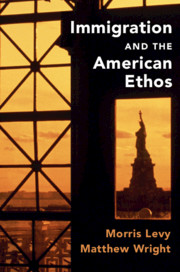Book contents
- Immigration and the American Ethos
- Cambridge Studies in Public Opinion and Political Psychology
- Immigration and the American Ethos
- Copyright page
- Contents
- Figures
- Tables
- Preface
- Prologue
- 1 What Do Americans Want from Immigration Policy, and Why?
- 2 Civic Fairness and Group-Centrism
- 3 Functional Assimilation, Humanitarianism, and Support for Legal Admissions
- 4 Civic Fairness and the Legal–Illegal Divide
- 5 Civic Fairness and Ethnic Stereotypes
- 6 Assimilation, Civic Fairness and the “Circle of We”
- 7 Conclusion
- Notes
- Bibliography
- Index
- Books in the series
6 - Assimilation, Civic Fairness and the “Circle of We”
Published online by Cambridge University Press: 25 January 2020
- Immigration and the American Ethos
- Cambridge Studies in Public Opinion and Political Psychology
- Immigration and the American Ethos
- Copyright page
- Contents
- Figures
- Tables
- Preface
- Prologue
- 1 What Do Americans Want from Immigration Policy, and Why?
- 2 Civic Fairness and Group-Centrism
- 3 Functional Assimilation, Humanitarianism, and Support for Legal Admissions
- 4 Civic Fairness and the Legal–Illegal Divide
- 5 Civic Fairness and Ethnic Stereotypes
- 6 Assimilation, Civic Fairness and the “Circle of We”
- 7 Conclusion
- Notes
- Bibliography
- Index
- Books in the series
Summary
The previous chapters demonstrated that liberal assimilationist norms are among the most powerful influences on American public opinion about immigration. Here, we examine two competing accounts of why this is so. As in the earlier chapters, we adjudicate between civic fairness and group-centrism. But having repeatedly shown that support for assimilation generally overrides ethnic group-centrism, we turn our attention to a different variety of group-centrism – one predicated on feelings of attachment to fellow members of the national ingroup and solidarity with immigrants who are seen as belonging within it.
- Type
- Chapter
- Information
- Immigration and the American Ethos , pp. 142 - 168Publisher: Cambridge University PressPrint publication year: 2020

